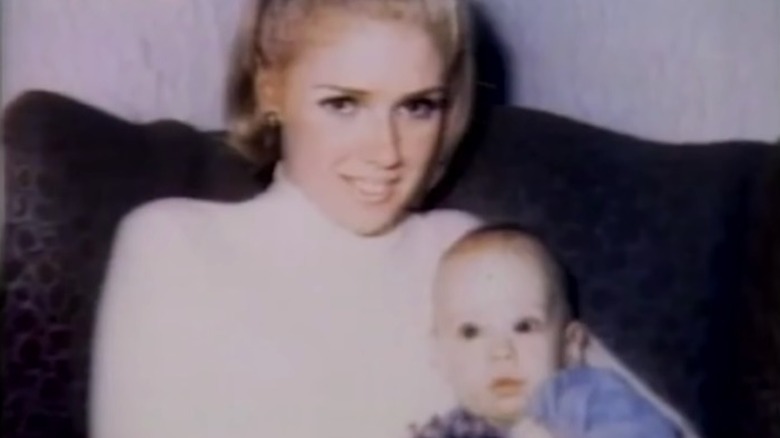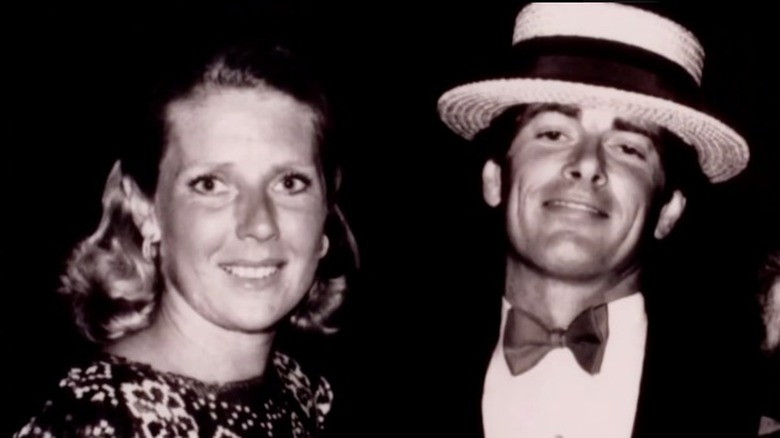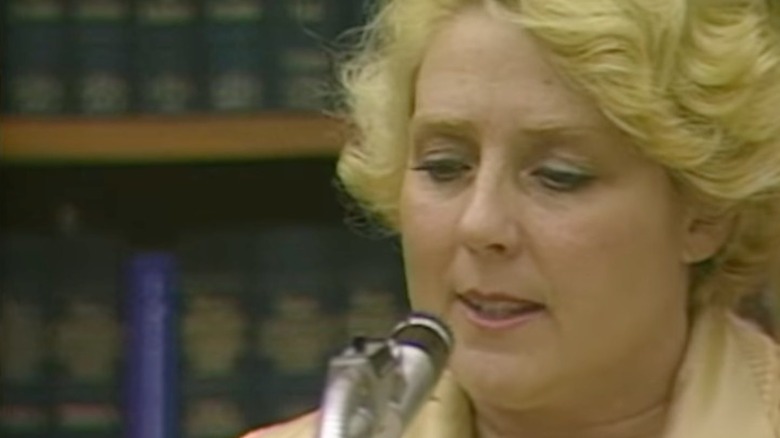The Bizarre Real-Life Story Of Betty Broderick
There's something oddly fascinating about a woman who has reached her breaking point. A bizarre statement? Sure. But it's one with plenty of evidence to back it up. From Euripides' Medea to Stieg Larsson's Lisbeth Salander, we can't get enough of women who mete out justice, whether it comes in the form of a passion-driven murder or eye-for-an-eye vigilantism. The same goes for true crime tales. Statistics say women have committed just 15 percent of all homicides in the U.S. since the 1960s, but when they do kill, they get all the coverage. Think Lizzie Borden and Aileen Wuornos.
Many explanations exist for the disproportionate focus on women who snap. Some people, like researcher Giovanna C. Lima, think deadly females capture the imagination because they defy our expectations of the feminine. Violent women challenge gendered roles traditionally attributed to women, shattering stereotypes about fragility, innocence, and dependability. Refinery 29 argues, "We feel shocked — almost betrayed by the idea that a woman could commit such a crime."
Some murderesses, like Betty Broderick, have attained near-mythic fame. Why? Because she shattered the 1950s stereotype of the housewife who grinned and bore her husband's cruelty and infidelities. Pushed to the breaking point, Broderick acted, and two people wound up dead. Nevertheless, there's more to this story than meets the eye.
A posh and traditional Catholic upbringing
On November 7, 1947, Elisabeth Anne Bisceglia came kicking and screaming into the world in a hospital in Bronxville, New York, per the Los Angeles Times. One of five children, she enjoyed a posh and traditional upbringing thanks to her Roman Catholic parents, Frank and Marita Bisceglia. A thriving New York City building contractor, Betty's father ensured that she and her siblings never wanted for anything.
Because of her upbringing, the future Betty Broderick grew up with certain expectations. These expectations included strict and traditional gender roles in every area, from household chores to the role of the breadwinner. Broderick also developed rigid ideas about how marriages worked and what the perfect mother looked like. She bought entirely into the "Leave It to Beaver" concept of home life.
As a Catholic, she also believed marriage meant forever. To this day, divorce is looked down upon in Catholicism, according to For Your Marriage. It may even impact a believer's ability to receive Holy Communion and the other sacraments. For Broderick, the best way to fulfill her role and ensure a happy life involved finding and marrying a fellow Catholic, one who shared her deeply held convictions. It also meant finding a man with the resources to support the posh upper-class upbringing to which she'd grown accustomed, per Esquire.
The society girl who settled for a working-class boy
Betty Broderick graduated from the all-women's College of Mount St. Vincent in New York with a degree in English, per the Los Angeles Times. In 1965, she met the man who changed her life forever: Daniel T. Broderick III. (Of course, she would return the favor in spades, cutting his life short.) Where did the star-crossed lovers-turned mortal enemies meet? At the University of Notre Dame, where Dan Broderick had just started medical school. Betty and a friend had traveled from New York to Indiana to watch a football game.
Dan Broderick introduced himself as an "MDA," or "medical doctor, almost," but Betty wasn't initially that impressed. In an interview with the Los Angeles Times, she said of her future husband, "I'm real tall and used to go out with athletic guys. He had long skinny sideburns, round tortoise-shell glasses. You're talking geek city." Nevertheless, he showered her with letters and telegrams. He eventually started calling her, and a relationship blossomed.
She appreciated his Catholic, albeit working-class, upbringing. She also liked his confidence and persistence, stating, "He promised me the moon. The guy asked me to marry him every day for three years."
Star-crossed lovers or mortal enemies?
While no Prince Charming in the traditional sense, Dan Broderick's ardency proved hard for Betty to resist. But her choice in men would cost her dearly. When Dan refused to sport a tuxedo for their wedding, opting instead for a suit, it angered Betty's mother to no end. After that, her mother refused to store Betty's belongings, per the Los Angeles Times.
Instead, she insisted her daughter move into her new husband's small dorm room at Cornell, forcing her to leave behind a large family home and a maid to settle into college life. Betty was in for a rude awakening despite claiming to support traditional gender and marriage roles. Once their Caribbean honeymoon ended, the rose-colored glasses came off. Dan had strict expectations for his new bride, and they proved far from glamorous.
Author Bryna Taubman chronicled Betty Broderick's life in her book "Hell Hath No Fury: A True Story of Wealth and Passion, Love and Envy, and a Woman Driven to the Ultimate Revenge." Speaking of their post-marriage life, Betty recalled how she quickly came to rue her decision and the loss of independence it ushered in. Overnight, she went from possessing assets and a car to nothing. She claimed her husband "was in charge of everything. I moved in with him and he took charge of the bank books and my paychecks, and I more or less had to do what he said."
Betty Broderick's honeymoon ended quickly
Not long after the wedding, Betty Broderick wanted a divorce and made her feelings known to her husband, per the Los Angeles Times. But she also got pregnant with their first child, thwarting her departure. They decided to stick it out, although both expressed regret about their nuptials. Despite Dan Broderick's domestic demands on his wife, he also expected her to support the family while he finished medical school at Cornell.
According to Oprah Daily, she worked as a third-grade teacher and babysitter. When needed, she supplemented their income by selling Tupperware and Avon. Eventually, Dan decided on a detour in his career: law school at Harvard. She went along with that, too. They lived paycheck-to-paycheck while Dan attended classes, and Betty built a life for herself, enriched by her career and friends.
Dan dove into his studies with gusto, developing a work ethic that verged on workaholic. His ultimate goal? To secure fabulous success and wealth for the family. But his approach to building a career also ensured a lack of marital involvement. Betty Broderick chalked up the absence of her husband as a necessary sacrifice.
The Brodericks outwardly lived the American Dream
The Broderick family moved to La Jolla, California, in 1973 when Dan received a job offer as a medical malpractice lawyer, per Esquire. Over time, he worked his way up through the esteemed ranks of Gray, Cary, Ames, & Frye. Within five years, Dan had garnered enough success and clients to open his own law practice, soon earning $1 million per year. (That's the equivalent of $2.5 million nowadays!)
Despite lean college years, the Brodericks quickly learned how to spend extravagantly, according to Town & Country. By the 1980s, they were fixtures of SoCal society, enjoying only the best money could buy and the country club memberships to prove it. Burl Stiff, society columnist for the San Diego Union, referred to them as "central casting for early yuppie" (via the Los Angeles Times).
From a ski condo in Colorado to a mansion in La Jolla with two maids and plenty of toys (as in boats, cars, and so on), they looked like the American Dream, at least from a distance. Only the most prestigious schools would do for their kids; you get the idea. But the outward displays of affluence didn't stop there. The Brodericks also knew how to dress the part. Stiff remembers Dan Broderick "always [looking] straight from Polo." And as for Betty Broderick? He writes, "She always had very pretty clothes — Oscar de la Renta and the like."
Unresolved feelings simmering beneath the surface
The move to La Jolla represented everything Dan had worked so hard to achieve, according to Esquire, and Betty Broderick presented a good face. But she would later relate in multiple interviews a feeling of complete uprooting as she left behind her career and friends to move to California. She threw herself into the role of a full-time soccer mom as passive-aggressive rage seethed beneath the surface. Would she ever acknowledge this? Perhaps not, but these repressed feelings seem palpable in later interviews.
According to Marie Claire, it didn't help that Dan wouldn't let Betty use birth control, resulting in nine pregnancies in 16 years of marriage. According to Betty, she transformed into an uber-mom, sacrificing her identity, dreams, and entire life to ensure that their four kids enjoyed every opportunity money could buy, from after-school lessons and sports to kid-friendly vacations (without Dan). The consummate overachiever, Dan worked 14- to 15-hour days, while Betty carted the kids around and kept up appearances in the social scene (via "The Oprah Winfrey Show").
As she would tearfully tell Oprah, "Being a super mom was the only thing I ever wanted to be in life ... Dan went out and slayed the dragons and provided for us, and I was home and hearth and children and support[ed] my husband emotionally through the good times and the bad."
Love and hate are strange bedfellows
Despite her unhappiness, Betty Broderick painted the marriage and family that she and Dan created together as ideal, "Leave It to Beaver" on steroids. In a 1992 interview with Oprah Winfrey, Broderick claimed, "I thought we did have a perfect marriage. ... When we met, we were very happy together."
But Larry Broderick (pictured), Dan Broderick's brother, tells a different tale about their marriage, claiming it was rocked by his sister-in-law's "avariciousness and her hate," feelings he claims persisted throughout the relationship. What's more, the toxic relationship appears to have gone both ways. During a marriage counseling session, notes written by Dan Broderick provide a window into a remote, detached mind. As reported by Esquire, Dan Broderick had decided to chase "financial security now so that I can get on with the important things in life." He also wrote about the necessity of attaining "certain necessary possessions" before he would consider the "luxury of being an attentive, thoughtful person." Quite a mindset for a husband and father of four!
According to the Broderick children, the heavily varnished 1950s depiction of their family unit alluded to by their mother in interviews represented a fiction. They claim their mother suffered from serious anger management issues that manifested violently. Episodes included spanking her children to the point of bruising and throwing things at her husband (via the Los Angeles Times).
Trouble comes packaged as a 22-year-old legal assistant
Nevertheless, the happy marriage narrative suited Betty Broderick, permitting her to focus intense hatred on so-called homewrecker Linda Kolkena. Kolkena became Dan's employee in 1983, providing a convenient target for Betty's rage (via Esquire). Her feelings were exacerbated by the sacrifices she'd made for her husband throughout their marriage, and, of course, the focus on Kolkena also let Betty off the hook when it came to taking personal responsibility for her role in the failing marriage.
But let's get one thing straight: Betty had justifiable cause for alarm with Dan Broderick's new paralegal. The 22-year-old former airline stewardess had no legal experience, no medical experience, and no administrative skills. She hadn't attended college, and she couldn't even type. Even worse, Linda looked eerily like a younger version of Betty (via Oxygen).
Despite a strict Catholic upbringing of her own, Kolkena had a history of mixing business with pleasure. Her stint as an airline attendant for Delta ended abruptly in 1982. Why? She got caught in "conduct unbecoming a Delta employee" while flying off-duty. According to reports, she sat on the lap of a drunken male passenger, used vulgar language, openly kissed him, and even snuck off to the bathroom with him. When confronted by on-duty flight attendants, she lied about her identity. But she later admitted guilt to all charges except joining the mile-high club.
A classic midlife crisis and a scandalous affair
What did Dan Broderick see in Linda Kolkena? She may have represented an escape for a man in the doldrums of a midlife crisis. The irony of the situation wasn't lost on Betty Broderick. In one of the most entertaining moments of her interview with Oprah, the short, curly-haired blond with the disarming face exclaimed, "It was an absolute classic mid-life crisis. ... [He] got the red corvette, the 'Risky Business' sunglasses, the scarf around his neck, the leather jacket. I told him he was the American joke."
Dan refused to admit to an affair with Kolkena, but the dynamic in their marriage changed radically. Almost overnight, he began hurling insults at Betty. He referred to her as old and fat, saying he didn't love her anymore (via Oprah). He also complained about the house and the kids incessantly.
Still hoping to save the marriage, Betty brought a gift and champagne to his office as a surprise for Dan's birthday. But the receptionist informed her that he was out with Linda. Unable to contain her fury, she burned his clothes in the backyard.
Gaslighting fanned the flames of revenge
Dan Broderick's approach to dealing with his wife's questions about infidelity lacked finesse. Each lie he told added fuel to the fire. He gaslighted Betty, denying the affair and calling her "crazy," per Medium. Today, we recognize gaslighting as a form of emotional and domestic abuse (via ABC News), but in the early 1980s, little awareness existed about this form of abuse or its dangerous psychological consequences.
As Cosley Law notes, a gaslighter "attempts to change that person's perception of reality." The result? Victims who feel confused or even question their sanity. While most would people assume it's the gaslighter who'd also engage in physical violence, in the case of Betty Broderick, the gaslighter became the victim. Or, perhaps more accurately, the "gaslighters," because Broderick always alleged that Linda Kolkena was in on it, too.
Betty claimed, though never confirmed, that Kolkena sent her taunting letters, ranging from ads for beauty cream and weight loss treatments to notes gloating about her relationship with Dan (via the Los Angeles Times). Of course, gaslighting is no excuse for murder. But it still sent Betty Broderick over the edge.
One of the messiest divorces in American history
Soon, the former dream couple sat locked in one of the messiest divorces ever seen in an American courtroom, stretching five long years and providing fodder for tabloids. As Vickie Jensen observes in "Women Criminals," Dan Broderick dominated the courtroom. "The San Diego legal community cooperated with Dan in his campaign to deprive Betty of the couple's shared assets. ... Dan knew the legal ropes and used them."
Betty's antics outside the courtroom also became increasingly menacing. Acts of retaliation turned into cause for serious concern, ranging from property damage to home invasion and even driving a car into Dan's front door, per Oprah Daily. Among Betty's most infamous retaliatory actions? Spray-painting the walls and curtains in Dan Broderick's home and smearing a Boston cream pie all over his bed. In another incident, she threw a wine bottle, smashing a window. But the harassment didn't end there. She put holes in the wall and left obscene voice messages on the answering machine.
Most repugnantly, she left the children unexpectedly at their father's house one by one, where they waited for his return. As Dan told the San Diego Reader, Betty "would just leave them there with their personal things, their clothes, and wouldn't tell me they were coming, and just drop them there."
Betty Broderick's marriage ended with a bang (or three)
But nothing could prepare Dan and Linda, by then newlyweds, for Betty Broderick's final act of revenge: their shooting deaths on November 5, 1989 (via Oprah Daily). Betty ambushed the couple while they lay in bed at their home in Marston Hills, San Diego. Without hesitation, she fired five shots from her .38-caliber in the pair's direction (via the Los Angeles Times). Despite her haphazard aim, Betty hit Linda in the neck and head and Dan through the right lung. Before leaving the scene, she tore the phone line out of the wall so that no one could call for help.
Two sensational trials would ensue, with Betty ultimately receiving 32 years to life. She remains in prison today. Broderick would make a bold claim following the double murder, arguing that shooting them represented an act of self-defense. But how could she make such a claim, especially since she showed up in Dan and Linda's bedroom, shooting them in cold blood?
Betty stated, "My lawyers hate it, because there's no law that says I can defend myself against his type of onslaught. He was killing me — he and she were still doing it — in secret." Betty Broderick became a rallying point for housewives who felt gaslighted or abused by their husbands, and her case still fascinates the public as "Dirty John: The Betty Broderick Story" proves. Betty now controls the narrative, the last one standing in a vicious love triangle.
She claims to be a political prisoner
Betty Broderick's stunning claim that she acted in self-defense when gunning down Dan and Linda Broderick wouldn't be the only sensational argument the housewife-turned-murderess would make, per People. In 2017, officials denied her parole request for the second time, which means she will molder away in the California Institute for Women until 2032, her next eligible date for parole. Ten years from now, she'll be 84 years old.
After her last parole denial hearing, Broderick penned a 4-page letter voicing frustration about her imprisonment into the foreseeable future. She wrote, "I have no one to speak for me. This was a case of domestic abuse: a pattern of coercive control that lasted throughout our marriage until the day I killed them" (via People). She also claims that she's met the stipulations necessary to have her request granted. Claiming they have no reason to deny her parole, she concluded that she's a political prisoner.
During the 11-hour hearing, Broderick appeared before a 2-member parole board who both agreed she should continue her sentence for 15 years, the longest possible term, according to the San Diego Tribune. Deputy District Attorney Richard Sachs argued against her release, stressing her unrepentant attitude. Besides Sachs, approximately 18 others made statements at her hearing. Based on Broderick's refusal to take responsibility for the double murder — arguing that Dan and Linda Broderick made her do it — Sachs appears to have a point.
Betty Broderick's life (and love letters) behind bars
Although Betty Broderick always emphasized her husband's extra-marital affair with his much younger legal secretary, she kept somebody on the side, too, according to the Los Angeles Times. Bradley T. Wright, a skilled sailor and successful entrepreneur who owned a fence building company, supported her emotionally and financially for years.
After the divorce, Broderick and Wright lived together on and off in her home, developing a domestic routine (complete with honey-do lists) and enjoying a sizzling sex life (via Oxygen). But Broderick felt uncomfortable about their age gap. Wright was six years her junior, which made her hesitant to go public with the relationship. Fatefully, Wright discovered the dead bodies of Dan and Linda Broderick on the morning his girlfriend shot them; their relationship was never the same.
After her sentencing in 1991, Betty Broderick kept in touch with Wright via letters, as reported by CBS 8. In return, he sent thousands of dollars to her. Wright kept his former flame's love letters, spanning from 2003 to 2006, in a storage locker in Sorrento Valley. But after neglecting to pay the rental fee, his locker got auctioned off along with Betty Broderick's love letters, per Distractify. Soon, they resurfaced in the media, causing a fervor. Understandably, Wright didn't relish the attention: "For me personally, it [was] just like reopening a sore wound that I've tried, after all this time, to sort of fade away."
Betty Broderick's relationship with her kids today
Over the years, Betty Broderick stayed in touch with her children: Kim, Lee, Dan Jr., and Rhett (via Oprah Daily). She told The San Diego Reader in 1998 that her children visit on Mother's Day and her birthday. But she wouldn't let them come for Christmas or other major holidays to avoid having too many prison-related memories. In 2009, Broderick submitted a family portrait snapped in prison with her kids to LA Magazine, and she claimed in her 2015 memoir that she saw her children and grandkids often.
Before the 2017 parole hearing, Betty Broderick had another hearing in 2010 where her children, Dan Broderick Jr. and Lee Broderick, testified. They remained split when it came to whether their mother should get released. Dan Broderick Jr. argued she should stay behind bars due to her lack of remorse. But Lee Broderick said she had a room prepared for her mother, believing she should enjoy her elderly years as a free woman.
As Marie Claire explains, Broderick's relationship with her children remains complicated. Lee and Rhett Broderick have made their peace and would like to see her released. But Dan and Kim Broderick have shown greater ambivalence, testifying (respectively) about their mother's lack of guilt and erratic and abusive behavior. Ultimately, Dan Broderick Jr.'s sentiments echo a 2017 parole official's conclusion: "To this day she believes in her heart and in her mind that [Dan and Linda Broderick] deserved to die," per CBS 8.















